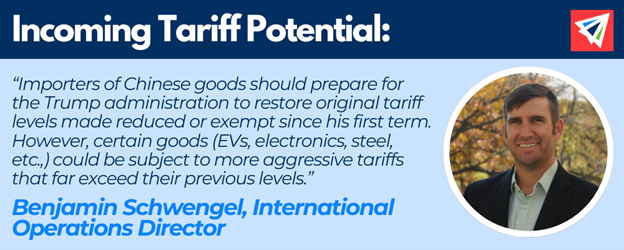Across International Shipping: News and Developments
[Regulation] Trump Tariffs Could Target Canada, Mexico: President-elect Donald Trump announced Nov. 25 that he plans to implement 25 percent tariffs on all goods coming into the U.S. from Canada and Mexico.
The new policy would be in violation of an existing trade pact between the three countries. However, Trump has vowed to undue the agreement via executive order. A move he says he will enact on day one in office.
[Labor] ILA-USMX Talks: A setback has paused negotiations for a new East/Gulf longshore contract. The two parties resumed talks in early November after reaching a partial tentative agreement last month. For more information, refer to the freight news section further below in the newsletter.
[Labor] Montreal Port Employers, Union Agree to Mediation: The Port of Montreal’s longshore union and maritime employers have agreed to mediation in their contract negotiations. In a joint release, the two sides said the mediation period will last 90 days.
The decision is a step forward in a hopeful resolution to a dispute that’s seen several labor-related actions taken by both sides. In the late summer and early fall, unionized dockworkers staged occasional strikes at key terminals and refused overtime work. In early November, employers locked out workers.
On Nov. 12, Canada Labor Minister Steve MacKinnon referred the dispute to binding arbitration, a legal process that would have forcibly placed government-assigned mediators to determine a settlement. Motivated to avoid government intervention, the two sides mutually agreed to assign their own independent mediator.
IMPORT: Asia to North America (Transpacific Eastbound)
Rates: Rates have stayed level over several weeks but remain high when compared to pre-pandemic levels.
Demand: Uncertainty over new and/or increased tariffs in the incoming U.S. presidential administration has motivated many importers to bring cargo in earlier.
Capacity: In early 2025 there could be an excess of available vessel capacity. This could prompt ocean carriers to implement blank sailing programs.
Congestion: Rail container dwell times have improved at the ports of Los Angeles and Long Beach.
TIPS:
- Early 2025 will feature events that could greatly impact international shipping: a shift in trade policy from an incoming presidential administration; Chinese New Year; and a potential longshore strike if ILA-USMX fail to secure a new contract before their mid-January deadline.
- As the year reaches its end, Q4 can be the right time to get a head start on your 2025 transportation and logistics strategies. While business needs can vary, in most cases, a discussion and evaluation of service providers (carriers, forwarders, Customs brokers, etc.,) should be top of mind, especially as it relates to any potential shortcomings in existing providers throughout 2024.
IMPORT: Europe to North America (Transatlantic Westbound)
2025 Services: Major carriers continue to unveil upcoming changes to their transatlantic offerings, including additional options to the Caribbean and South America.
Rates: Aside from a traditional round of peak season surcharges (PSSs), rates have generally shown little change since early fall.
Capacity: Available capacity at Europe ports have shown some signs of strain.
EXPORT: North America to Asia
Rates: Outbound rates to Asia from the U.S. East Coast have decreased slightly. Meanwhile, U.S. West Coast to Asia services remain at steady rate levels.
Space: Progress in improving container dwell times at U.S. West Coast ports has benefited export movement.
